INTRODUCTION, PART 1
Hello to All,
I have been doing extensive research on this Topic for a while now...it was a recent message dropped at my You Tube Chanel by a Member here...Vidbid...that "reactivated" my desires to conclude all this search and development. And I will need all your help in proving all this Material is completely real.
I consider it is a fascinating phenomena that We have left behind due to the Higher Development of the Two Piece (Rotor-Stator) Generator Machines...but let's go back in time to 1831...to Faraday's Experimental Lab:
By the year 1831... chemical reactions were obtaining electricity, the Leyden Jar Batteries were invented...and based on those generated currents, many were creating electromagnets or artificially generated magnetic fields based on coils ( Hans Christian Ørsted in 1820 discovered a deflection on his compass needle when conductors carrying currents from batteries were approached, then André-Marie Ampère in 1825 invented the Solenoid or Coil) ...Faraday wanted to "reverse" this process...He knew if electricity could create a magnetic field...then the inverse process could be possible...obtaining electricity from a Magnetic Field.
Faraday primary experiments were done with Permanent Magnets...and not Electromagnets...why?
A Permanent Magnet has its own "Independent and Self Generating Field"...that do not require any external input nor spending of energy...therefore, besides experiments having a simple approach, the "proof of concept" would be radical.
Faraday conducted many experiments , all reported to the Royal Society Institution of London, Faraday built the hand rotating Homopolar Generator...and basically Three combinations/probabilities were tested:
1-Static Magnets/Rotating Disc.
2-Stationary Disc/Rotating Magnets
3-All (Disc and Magnets) rotating
Out of this Three, the Second was disregarded as no deflection on the needle of his Galvanometer was obtained...But, First and Third Tests were successful. The Primary one lead to using a single conductor of copper...that later derived in the actual Two Piece Generator complex Coils arrangement Machines that we all have up to now.
However, the Third arrangement, even though caused exactly same needle deflection...was not fully developed like the First one did over the coming Centuries...
Faraday was actually more impressed by the last test (3)...than by the primary one, leading him to build further Geometries and experiments besides the Disc and the Horseshoe Magnet we all know...
EARTH-INDUCTORS...
Faraday and the Ether (Intervening Medium)
FARADAY PAPERS TO ROYAL SOCIETY: TERRESTRIAL MAGNETO ELECTRIC INDUCTION (1832)
He sent to the Royal Society an account of these and the earlier experiments; his paper on terrestrial magneto-electric induction, and on the force and direction of magneto-electric induction, received the distinction of being read as the Bakerian lecture of the year.
This Studies and Experiments from Faraday related to Earth Magnetic Field and Induction continued through the following years, it is impossible to upload everything into this Post...but I encourage you to read the Literature I link at the end of all this Material.
I have tried to set this paper as brief and extracted as possible without missing the important/relevant aspects We all need to know, in order to elaborate further developments and new type of machines...
Hello to All,
I have been doing extensive research on this Topic for a while now...it was a recent message dropped at my You Tube Chanel by a Member here...Vidbid...that "reactivated" my desires to conclude all this search and development. And I will need all your help in proving all this Material is completely real.
Hi, ufopolitics. I hope you're doing well. You know, you can build a generator that produces electricity with no relative motion between the rotor and the magnet. It's true, but instead of using a coil, you use a disk, and get this: the magnet is connected to the disc, and both are rotated, and a current is generated. No relative motion is needed. Check out Bruce De Palma's N-machine and how it works. Good luck.
By the year 1831... chemical reactions were obtaining electricity, the Leyden Jar Batteries were invented...and based on those generated currents, many were creating electromagnets or artificially generated magnetic fields based on coils ( Hans Christian Ørsted in 1820 discovered a deflection on his compass needle when conductors carrying currents from batteries were approached, then André-Marie Ampère in 1825 invented the Solenoid or Coil) ...Faraday wanted to "reverse" this process...He knew if electricity could create a magnetic field...then the inverse process could be possible...obtaining electricity from a Magnetic Field.
Faraday primary experiments were done with Permanent Magnets...and not Electromagnets...why?
A Permanent Magnet has its own "Independent and Self Generating Field"...that do not require any external input nor spending of energy...therefore, besides experiments having a simple approach, the "proof of concept" would be radical.
Faraday conducted many experiments , all reported to the Royal Society Institution of London, Faraday built the hand rotating Homopolar Generator...and basically Three combinations/probabilities were tested:
1-Static Magnets/Rotating Disc.
2-Stationary Disc/Rotating Magnets
3-All (Disc and Magnets) rotating
Out of this Three, the Second was disregarded as no deflection on the needle of his Galvanometer was obtained...But, First and Third Tests were successful. The Primary one lead to using a single conductor of copper...that later derived in the actual Two Piece Generator complex Coils arrangement Machines that we all have up to now.
However, the Third arrangement, even though caused exactly same needle deflection...was not fully developed like the First one did over the coming Centuries...
Faraday was actually more impressed by the last test (3)...than by the primary one, leading him to build further Geometries and experiments besides the Disc and the Horseshoe Magnet we all know...
EARTH-INDUCTORS...
[IMG]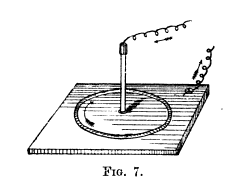 [/IMG]
[/IMG]
In one,* a Hat ring of twelve inches' external diameter, and one inch broad, was cut from a thick copper plate, and mounted to revolve between the poles of the magnet, two conductors being applied to make rubbing contact at the inner and outer edge at the part which passed between the magnetic poles.
In another,t a disc of copper, one-fifth of an inch thick and only Ii inch in diameter (Fig. 7), was amalgamated at the edge, and mounted on a copper axle. A square piece of sheet metal had a circular hole cut in it, into which the disc fitted loosely; a little mercury completed communication between the disc and its surrounding ring. The latter was connected by wire to a galvanometer; the other wire being connected from the instrument to the end of the axle. Upon rotating the disc in a horizontal plane, currents were obtained, though the earth was the only magnet employed.
 [/IMG]
[/IMG]In one,* a Hat ring of twelve inches' external diameter, and one inch broad, was cut from a thick copper plate, and mounted to revolve between the poles of the magnet, two conductors being applied to make rubbing contact at the inner and outer edge at the part which passed between the magnetic poles.
In another,t a disc of copper, one-fifth of an inch thick and only Ii inch in diameter (Fig. 7), was amalgamated at the edge, and mounted on a copper axle. A square piece of sheet metal had a circular hole cut in it, into which the disc fitted loosely; a little mercury completed communication between the disc and its surrounding ring. The latter was connected by wire to a galvanometer; the other wire being connected from the instrument to the end of the axle. Upon rotating the disc in a horizontal plane, currents were obtained, though the earth was the only magnet employed.
[IMG]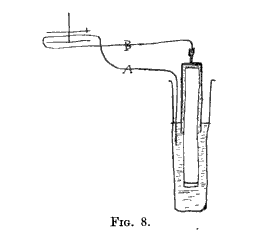 [/IMG]
[/IMG]
In another apparatus, * a copper cylinder (Fig. 8), closed at one extremity, was put over a magnet, one half of which it enclosed like a cap, and to which it
was attached without making metallic contact. The arrangement was then floated upright in a narrow jar of mercury, so that the lower edge of the copper cap touched the fluid. On rotating the magnet and its attached cap, a current was sent through wires from the mercury to the top of the copper cap. In another apparatus, still preserved at the Royal Institution, a cylindrical bar magnet, half immersed in mercury, was made to rotate, and generated a current, its own metal serving as a conductor.
In another form, the cylindrical magnet was rotated horizontally about its own axis, and was found to generate currents which flowed from the middle to the ends, or vice versa, according to the rotation.
 [/IMG]
[/IMG]In another apparatus, * a copper cylinder (Fig. 8), closed at one extremity, was put over a magnet, one half of which it enclosed like a cap, and to which it
was attached without making metallic contact. The arrangement was then floated upright in a narrow jar of mercury, so that the lower edge of the copper cap touched the fluid. On rotating the magnet and its attached cap, a current was sent through wires from the mercury to the top of the copper cap. In another apparatus, still preserved at the Royal Institution, a cylindrical bar magnet, half immersed in mercury, was made to rotate, and generated a current, its own metal serving as a conductor.
In another form, the cylindrical magnet was rotated horizontally about its own axis, and was found to generate currents which flowed from the middle to the ends, or vice versa, according to the rotation.
The description of these new electrical machines is concluded by Faraday with the following pregnant words :-
All Reference above :Michael Faraday, his life and work (1898)
I have rather, however, been desirous of discovering new facts and relations dependent on magneto-electric induction, than of exalting the force of those already obtained ; being assured that. the latter would find their full development hereafter.
All Reference above :Michael Faraday, his life and work (1898)
The mathematicians, Laplace and Poisson at their head, had seized on this demonstration and had elaborated their mathematical theories.
Before them, though the research. lay for a century unpublished, Cavendish had shown that the only law of force as between one element of an electric charge and another compatible with a charge being in equilibrium was the law of inverse squares. But in all these mathematical reasonings one thing had been quite left out of sight-namely, the possible properties of the intervening medium.
Faraday, to whom the idea of mere action at a distance was abhorrent, if not unthinkable, conceived of all these forces of attraction and repulsion as effects taking place by something going on in the intervening medium.
Before them, though the research. lay for a century unpublished, Cavendish had shown that the only law of force as between one element of an electric charge and another compatible with a charge being in equilibrium was the law of inverse squares. But in all these mathematical reasonings one thing had been quite left out of sight-namely, the possible properties of the intervening medium.
Faraday, to whom the idea of mere action at a distance was abhorrent, if not unthinkable, conceived of all these forces of attraction and repulsion as effects taking place by something going on in the intervening medium.
He sent to the Royal Society an account of these and the earlier experiments; his paper on terrestrial magneto-electric induction, and on the force and direction of magneto-electric induction, received the distinction of being read as the Bakerian lecture of the year.
The following summary of this second paper is from the pen of Professor Tyndall :-
He (Faraday) placed a bar of iron in a coil of wire, and lifting the
bar into the direction of the dipping needle, he excited by this
action a current in the coil. On reversing the bar, a current
in the opposite direction rushed through the wire. The same
effect was produced, when, on holding the helix in the line of
dip, a bar of iron was thrust into it. Here, however, the earth
acted on the coil through the intermediation of the bar of iron.
He abandoned the bar, and simply set a copper plate spinning
in a horizontal plane; he knew that the earth's lines of
magnetic force then crossed the plate at an angle of about 70º.
When the plate spun round, the lines of force were intersected
and induced currents generated, which produced their proper
affect when carried from the plate to the galvanometer .
.. When the plate was in the magnetic meridian, or in any
other plane coinciding with the magnetic dip, then its rotation
produced no effect upon the galvanometer."
He (Faraday) placed a bar of iron in a coil of wire, and lifting the
bar into the direction of the dipping needle, he excited by this
action a current in the coil. On reversing the bar, a current
in the opposite direction rushed through the wire. The same
effect was produced, when, on holding the helix in the line of
dip, a bar of iron was thrust into it. Here, however, the earth
acted on the coil through the intermediation of the bar of iron.
He abandoned the bar, and simply set a copper plate spinning
in a horizontal plane; he knew that the earth's lines of
magnetic force then crossed the plate at an angle of about 70º.
When the plate spun round, the lines of force were intersected
and induced currents generated, which produced their proper
affect when carried from the plate to the galvanometer .
.. When the plate was in the magnetic meridian, or in any
other plane coinciding with the magnetic dip, then its rotation
produced no effect upon the galvanometer."
At the suggestion of a mind fruitful in suggestions of a profound and philosophic character-I mean that of Sir John Herschel-Mr. Barlow, of Woolwich, had experimented with a
rotating iron shell Mr. Christie had also performed an elaborate series of experiments on a rotating iron disc. Both of them had found that when in rotation the body exercised a
peculiar action upon the magnetic needle, deflecting it in a manner which was not observed during quiescence; but neither of them was aware at the time of the agent which
produced this extraordinary deflection. They ascribed it to some change in the magnetism of the iron shell and disc.
But Faraday at once saw that his induced currents must come into play here, and he immediately obtained them from an iron disc. With a hollow brass ball, moreover, he produced the effects obtained by Mr. Barlow. Iron was in no way necessary; the only condition of success was that the rotating body should be of a character to admit of the formation of currents in its substance; it must, in other words, be a conductor of electricity. The higher the conducting power, the more copious were the currents.
He now passes from his little brass globe to the globe of the earth. He plays like a magician with the earth's magnetism. He sees the invisible lines along which its magnetic action is exerted, and, sweeping his wand across these lines, he evokes this new power. Placing a simple loop of wire round a magnetic needle, he bends its upper portion to the west; the north pole of the needle immediately swerves to the east; he bends his loop to the east, and the north pole moves to the west. Suspending a common bar magnet in a vertical position, he causes it to spin round its own axis. Its pole being connected with one end of a galvanometer wire, and its equator with the other end; electricity rushes round the galvanometer from the rotating magnet.
He remarks upon the "singular independence" of the magnetism and the body of the magnet which carries it.
The steel behaves as if it were isolated from its own magnetism. And then his thoughts suddenly widen, and he asks himself whether the rotating earth does not generate induced currents as it turns round its axis from west to east...
rotating iron shell Mr. Christie had also performed an elaborate series of experiments on a rotating iron disc. Both of them had found that when in rotation the body exercised a
peculiar action upon the magnetic needle, deflecting it in a manner which was not observed during quiescence; but neither of them was aware at the time of the agent which
produced this extraordinary deflection. They ascribed it to some change in the magnetism of the iron shell and disc.
But Faraday at once saw that his induced currents must come into play here, and he immediately obtained them from an iron disc. With a hollow brass ball, moreover, he produced the effects obtained by Mr. Barlow. Iron was in no way necessary; the only condition of success was that the rotating body should be of a character to admit of the formation of currents in its substance; it must, in other words, be a conductor of electricity. The higher the conducting power, the more copious were the currents.
He now passes from his little brass globe to the globe of the earth. He plays like a magician with the earth's magnetism. He sees the invisible lines along which its magnetic action is exerted, and, sweeping his wand across these lines, he evokes this new power. Placing a simple loop of wire round a magnetic needle, he bends its upper portion to the west; the north pole of the needle immediately swerves to the east; he bends his loop to the east, and the north pole moves to the west. Suspending a common bar magnet in a vertical position, he causes it to spin round its own axis. Its pole being connected with one end of a galvanometer wire, and its equator with the other end; electricity rushes round the galvanometer from the rotating magnet.
He remarks upon the "singular independence" of the magnetism and the body of the magnet which carries it.
The steel behaves as if it were isolated from its own magnetism. And then his thoughts suddenly widen, and he asks himself whether the rotating earth does not generate induced currents as it turns round its axis from west to east...
I have tried to set this paper as brief and extracted as possible without missing the important/relevant aspects We all need to know, in order to elaborate further developments and new type of machines...

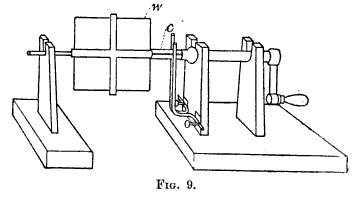
 ?
?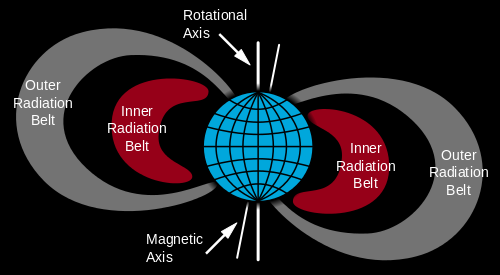
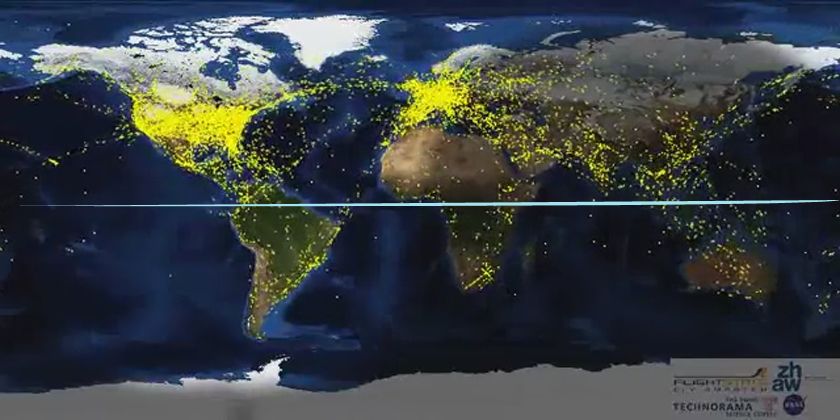
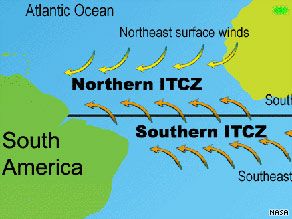
 )
)


Comment